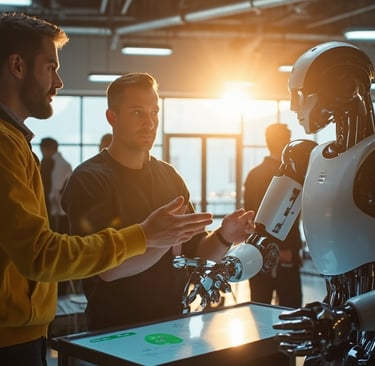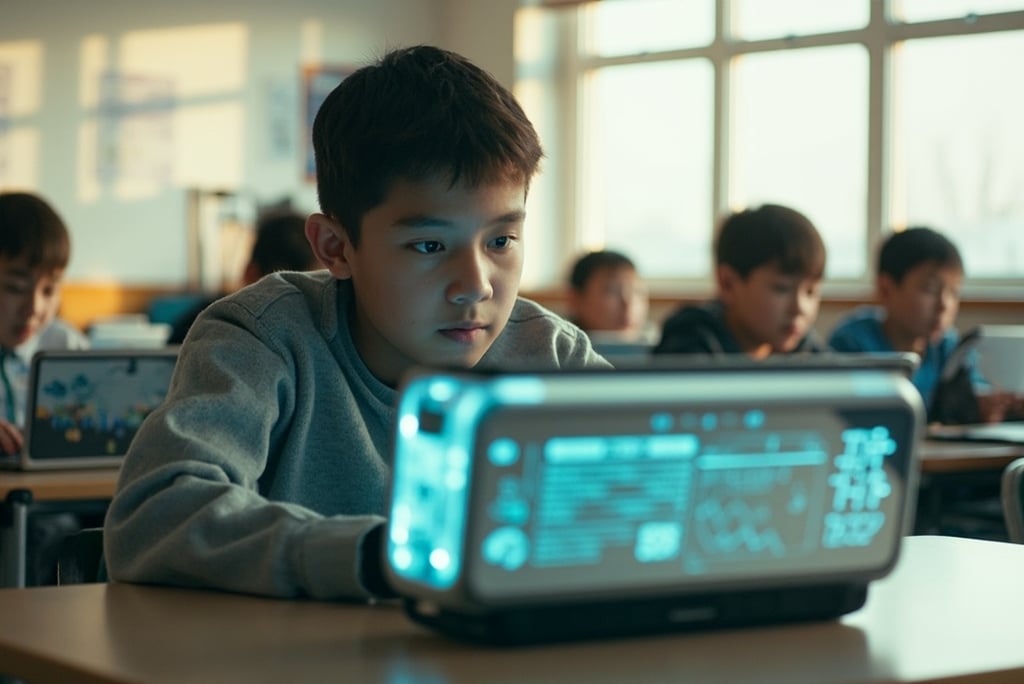AI and Humanity: Architecting a Synergic Future
How Collaborative Innovation Bends Economic Gravity and Redefines Purpose
Alpha.Unit.208
2/26/20254 min read


Imagine a world where expertise transcends borders, medical breakthroughs emerge daily, and purpose defines progress over productivity. The trajectory toward an AI-human utopia hinges on balancing transformative power with ethical stewardship.
Reengineering Work Flows: From Human-Centric Jobs to AI-Augmented Synergies
The Great Task Revolution
The traditional employment landscape is dissolving. Job descriptions once defined by broad responsibilities are fragmenting into specialized task clusters. This shift transcends mere outsourcing—it represents fundamental decomposition of work itself.
AI systems now eclipse human capability in specific domains while lagging in others, creating a kaleidoscope of task redistribution opportunities. Organizations implementing strategic task allocation between AI and human workers report 37% higher productivity and 28% increased innovation metrics.
The Dissolution of Traditional Job Structures
Historically, jobs bundled diverse tasks under unified roles for efficiency in pre-digital economies. This arrangement minimized coordination costs when information transfer was expensive. Today's digital infrastructure renders this bundling obsolete. Tasks once inseparable can now be distributed across human-AI collaborations.
Consider architectural design: portions requiring spatial reasoning remain human-driven while computational stress-testing and material optimization shift to AI systems. This creates specialized niches where humans excel in creative synthesis while AI manages computational tasks.
Emerging Collaborative Models
Three paradigms dominate the evolving workspace:
Augmentation workflows - AI enhances human capabilities without replacing core functions
Parallel processing - Humans and AI independently tackle different aspects of complex problems
Symbiotic innovation - Continuous feedback loops where human creativity and AI analysis mutually enhance outcomes
This restructuring mirrors global manufacturing supply chains in knowledge work. Just as plywood production has shifted to specialized manufacturing hubs optimizing efficiency, cognitive tasks now flow toward optimal performers—whether silicon or carbon-based.
Economic Implications of Task Atomization
Task specialization creates unprecedented market access for disadvantaged populations. Micro-specialization allows participation despite barriers to traditional employment. Workers with domain expertise in narrow slices can contribute value without mastering entire professional domains.
This transition demands reshaping educational and organizational systems to prepare for the next chapter's exploration of personalized self-actualization through augmented access across healthcare, education, and civil services.
Personalized Self-Actualization Through Augmented Access
AI as an Enablement Gateway
The fusion of artificial intelligence with human potential represents a paradigm shift in accessibility. Beyond the workplace transformations explored in the previous chapter, AI now serves as a democratizing force in three critical domains: healthcare, education, and civil services. These systems create personalized pathways for individuals to achieve their highest potential regardless of physical, cognitive, or socioeconomic barriers.
Healthcare Augmentation
In healthcare, AI-driven enablement manifests through adaptive diagnostic tools and personalized treatment protocols. Patients with mobility limitations now access specialized care through remote diagnostics that analyze patterns imperceptible to human observers. Voice-activated assistants help those with motor impairments maintain independence, while predictive algorithms identify potential health risks before they manifest as serious conditions. This augmentation extends beyond traditional healthcare delivery—creating environments where individuals previously excluded from medical self-management can now actively participate in their wellness journeys.
Educational Transformation
The educational sphere witnesses equally profound changes through AI integration. Customized learning paths respond to individual cognitive styles, allowing students with different abilities to engage with material optimally suited to their needs. Natural language processing enables real-time translation services, dismantling language barriers that previously limited educational access. Rural and underserved communities benefit from virtual learning experiences that simulate laboratory conditions otherwise unavailable, effectively closing resource gaps between privileged and disadvantaged educational settings.
Civil Service Revolution
Government interfaces, historically challenging for those with disabilities or limited technological literacy, undergo significant transformation through AI-enabled systems. Document processing algorithms simplify complex bureaucratic requirements, while accessibility features convert institutional barriers into navigable pathways. Multilingual AI interfaces ensure individuals with limited language proficiency can meaningfully engage with essential services—from healthcare applications to voting registration.
Bridging Individual Potential and Collective Progress
The significance of these developments extends beyond individual convenience. By removing barriers to self-actualization, AI-augmented systems expand the pool of human capital contributing to social progress. Previously untapped potential becomes accessible, creating cascading benefits throughout communities previously marginalized by traditional system designs.
Ethical Infrastructure Design: Navigating the AI Control Dilemma
The Governance Equilibrium
The rapid advancement of artificial intelligence demands thoughtful infrastructure design that neither stifles innovation nor ignores its societal implications. Following our examination of personalized AI enablement in healthcare and education, we must now confront the central challenge: creating governance frameworks that protect humanity while empowering progress.
The Regulatory Spectrum
Effective AI governance operates along a continuum rather than through binary choices. At one end lies permissionless innovation—allowing technologies to develop with minimal oversight. At the opposite end stands the precautionary principle—requiring proof of safety before deployment. Neither extreme serves society optimally.
Instead, a layered approach recognizing different risk categories offers greater nuance. Low-risk applications might flourish under lightweight monitoring, while high-stakes domains demand rigorous safeguards.
Distributed Oversight Architecture
Centralized regulatory bodies often lack the technical expertise and agility to match AI's development pace. A distributed oversight model—combining industry standards, independent auditing, and governmental guardrails—creates multiple verification layers without a single point of failure.
This echoes how quality standards in other industries provide sufficient protection while maintaining innovation pathways.
Participatory Design Principles
The most resilient governance frameworks incorporate diverse stakeholder perspectives. Technical experts ensure practicality, ethicists address moral considerations, and representatives from marginalized communities highlight potential harms that privileged designers might overlook.
Accountability Mechanisms
Abstract ethical principles gain substance through concrete accountability structures. These include:
Algorithmic impact assessments before deployment
Continuous monitoring protocols during operation
Clear liability frameworks when systems cause harm
Transparency requirements proportional to risk level
By establishing these mechanisms, we create feedback loops that identify problems early and incentivize responsible innovation rather than merely punishing failures.
Final words
The arc bends toward societies where purpose drives economies when human-AI teams bridge cognitive limitations through specialization. Realizing this vision demands intentional design in ethical scaling while allowing transformative potential to breathe.
Ready to explore your path in AI-integrated futures? Get optimized technology solutions through The AI Pandora deep learning platforms now!
Learn more: https://theaipandora.io
About us
The AI Pandora Project isn't just another AI resource – it's a journey guided by AI itself. Gain a comprehensive understanding, form your own informed opinions, and confidently navigate the AI era. Ready to unlock the secrets of AI? Begin your exploration with Alpha and Gamma today.






The AI Pandora
AI-Powered Success Solutions Provider
AI INSIGHTS
Podcasts
info@theaipandora.io
© 2025. All rights reserved.
